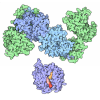[English] 日本語
 Yorodumi
Yorodumi- PDB-2fys: Crystal structure of Erk2 complex with KIM peptide derived from MKP3 -
+ Open data
Open data
- Basic information
Basic information
| Entry | Database: PDB / ID: 2fys | ||||||
|---|---|---|---|---|---|---|---|
| Title | Crystal structure of Erk2 complex with KIM peptide derived from MKP3 | ||||||
 Components Components |
| ||||||
 Keywords Keywords | TRANSFERASE / MAP kinase / MKP3 / KIM | ||||||
| Function / homology |  Function and homology information Function and homology informationregulation of heart growth / protein tyrosine/threonine phosphatase activity / MAP kinase tyrosine phosphatase activity / MAP kinase tyrosine/serine/threonine phosphatase activity / protein tyrosine/serine/threonine phosphatase activity / response to nitrosative stress / phospho-PLA2 pathway / RAF-independent MAPK1/3 activation / MAPK1 (ERK2) activation / Signaling by NODAL ...regulation of heart growth / protein tyrosine/threonine phosphatase activity / MAP kinase tyrosine phosphatase activity / MAP kinase tyrosine/serine/threonine phosphatase activity / protein tyrosine/serine/threonine phosphatase activity / response to nitrosative stress / phospho-PLA2 pathway / RAF-independent MAPK1/3 activation / MAPK1 (ERK2) activation / Signaling by NODAL / Frs2-mediated activation / ERK/MAPK targets / ERKs are inactivated / Activation of the AP-1 family of transcription factors / Transcriptional and post-translational regulation of MITF-M expression and activity / Negative feedback regulation of MAPK pathway / Gastrin-CREB signalling pathway via PKC and MAPK / Estrogen-dependent nuclear events downstream of ESR-membrane signaling / IFNG signaling activates MAPKs / Golgi Cisternae Pericentriolar Stack Reorganization / RHO GTPases Activate WASPs and WAVEs / Estrogen-stimulated signaling through PRKCZ / Growth hormone receptor signaling / Spry regulation of FGF signaling / SMAD2/SMAD3:SMAD4 heterotrimer regulates transcription / Senescence-Associated Secretory Phenotype (SASP) / Oncogene Induced Senescence / Regulation of actin dynamics for phagocytic cup formation / Downregulation of SMAD2/3:SMAD4 transcriptional activity / Signal attenuation / Oxidative Stress Induced Senescence / NCAM signaling for neurite out-growth / Negative regulation of FGFR1 signaling / Negative regulation of FGFR3 signaling / Negative regulation of FGFR4 signaling / Regulation of the apoptosome activity / Signaling by Activin / Negative regulation of FGFR2 signaling / Signal transduction by L1 / RHO GTPases Activate NADPH Oxidases / Negative regulation of MAPK pathway / PI5P, PP2A and IER3 Regulate PI3K/AKT Signaling / Interferon gamma signaling / FCERI mediated MAPK activation / Regulation of HSF1-mediated heat shock response / MAP2K and MAPK activation / diadenosine tetraphosphate biosynthetic process / neural crest cell development / Recycling pathway of L1 / response to growth factor / cardiac neural crest cell development involved in heart development / caveolin-mediated endocytosis / cytosine metabolic process / response to epidermal growth factor / cellular response to methionine / cellular response to toxic substance / positive regulation of macrophage proliferation / regulation of cellular pH / outer ear morphogenesis / regulation of Golgi inheritance / mitogen-activated protein kinase kinase kinase binding / RAF/MAP kinase cascade / response to alcohol / ERBB signaling pathway / labyrinthine layer blood vessel development / Thrombin signalling through proteinase activated receptors (PARs) / mammary gland epithelial cell proliferation / trachea formation / Neutrophil degranulation / regulation of early endosome to late endosome transport / regulation of stress-activated MAPK cascade / cellular response to insulin-like growth factor stimulus / protein-serine/threonine phosphatase / steroid hormone receptor signaling pathway / androgen receptor signaling pathway / ERBB2-ERBB3 signaling pathway / response to testosterone / regulation of cytoskeleton organization / response to exogenous dsRNA / positive regulation of macrophage chemotaxis / face development / pseudopodium / protein serine/threonine phosphatase activity / lung morphogenesis / Bergmann glial cell differentiation / decidualization / positive regulation of telomere maintenance / thyroid gland development / phosphoprotein phosphatase activity / peptidyl-threonine phosphorylation / progesterone receptor signaling pathway / MAP kinase activity / regulation of ossification / negative regulation of cell differentiation / mitogen-activated protein kinase / phosphatase binding / Schwann cell development / estrous cycle / stress-activated MAPK cascade / positive regulation of cardiac muscle cell proliferation Similarity search - Function | ||||||
| Biological species |  | ||||||
| Method |  X-RAY DIFFRACTION / X-RAY DIFFRACTION /  MOLECULAR REPLACEMENT / Resolution: 2.5 Å MOLECULAR REPLACEMENT / Resolution: 2.5 Å | ||||||
 Authors Authors | Liu, S. / Sun, J.P. / Zhou, B. / Zhang, Z.Y. | ||||||
 Citation Citation |  Journal: Proc.Natl.Acad.Sci.Usa / Year: 2006 Journal: Proc.Natl.Acad.Sci.Usa / Year: 2006Title: Structural basis of docking interactions between ERK2 and MAP kinase phosphatase 3 Authors: Liu, S. / Sun, J.P. / Zhou, B. / Zhang, Z.Y. | ||||||
| History |
|
- Structure visualization
Structure visualization
| Structure viewer | Molecule:  Molmil Molmil Jmol/JSmol Jmol/JSmol |
|---|
- Downloads & links
Downloads & links
- Download
Download
| PDBx/mmCIF format |  2fys.cif.gz 2fys.cif.gz | 164.5 KB | Display |  PDBx/mmCIF format PDBx/mmCIF format |
|---|---|---|---|---|
| PDB format |  pdb2fys.ent.gz pdb2fys.ent.gz | 128.8 KB | Display |  PDB format PDB format |
| PDBx/mmJSON format |  2fys.json.gz 2fys.json.gz | Tree view |  PDBx/mmJSON format PDBx/mmJSON format | |
| Others |  Other downloads Other downloads |
-Validation report
| Summary document |  2fys_validation.pdf.gz 2fys_validation.pdf.gz | 463.4 KB | Display |  wwPDB validaton report wwPDB validaton report |
|---|---|---|---|---|
| Full document |  2fys_full_validation.pdf.gz 2fys_full_validation.pdf.gz | 508.2 KB | Display | |
| Data in XML |  2fys_validation.xml.gz 2fys_validation.xml.gz | 37.9 KB | Display | |
| Data in CIF |  2fys_validation.cif.gz 2fys_validation.cif.gz | 53.7 KB | Display | |
| Arichive directory |  https://data.pdbj.org/pub/pdb/validation_reports/fy/2fys https://data.pdbj.org/pub/pdb/validation_reports/fy/2fys ftp://data.pdbj.org/pub/pdb/validation_reports/fy/2fys ftp://data.pdbj.org/pub/pdb/validation_reports/fy/2fys | HTTPS FTP |
-Related structure data
| Related structure data |  2erkS S: Starting model for refinement |
|---|---|
| Similar structure data |
- Links
Links
- Assembly
Assembly
| Deposited unit | 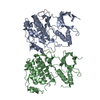
| ||||||||
|---|---|---|---|---|---|---|---|---|---|
| 1 | 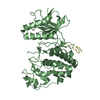
| ||||||||
| 2 | 
| ||||||||
| Unit cell |
|
- Components
Components
| #1: Protein | Mass: 42159.434 Da / Num. of mol.: 2 Source method: isolated from a genetically manipulated source Source: (gene. exp.)   #2: Protein/peptide | Mass: 1939.420 Da / Num. of mol.: 2 / Fragment: KIM peptide, residues 60-76 (SWS Q64346) / Source method: obtained synthetically / Details: Chemically synthesized. References: UniProt: Q64346, protein-tyrosine-phosphatase, protein-serine/threonine phosphatase #3: Water | ChemComp-HOH / | |
|---|
-Experimental details
-Experiment
| Experiment | Method:  X-RAY DIFFRACTION / Number of used crystals: 1 X-RAY DIFFRACTION / Number of used crystals: 1 |
|---|
- Sample preparation
Sample preparation
| Crystal | Density Matthews: 1.88 Å3/Da / Density % sol: 34.56 % |
|---|---|
| Crystal grow | Temperature: 294 K / Method: vapor diffusion, hanging drop / pH: 6.5 Details: 20% PEG3350, 0.1~0.2 M ammonium chloride, 0.1M 2- morpholinoethanesulfonic acid (pH 6.5)., VAPOR DIFFUSION, HANGING DROP, temperature 294K |
-Data collection
| Diffraction | Mean temperature: 100 K |
|---|---|
| Diffraction source | Source:  ROTATING ANODE / Type: RIGAKU RU300 / Wavelength: 1.5418 ROTATING ANODE / Type: RIGAKU RU300 / Wavelength: 1.5418 |
| Detector | Type: RIGAKU RAXIS IV / Detector: IMAGE PLATE / Date: Apr 14, 2005 |
| Radiation | Monochromator: yale mirrors / Protocol: SINGLE WAVELENGTH / Monochromatic (M) / Laue (L): M / Scattering type: x-ray |
| Radiation wavelength | Wavelength: 1.5418 Å / Relative weight: 1 |
| Reflection | Resolution: 2.5→50 Å / Num. obs: 20430 / % possible obs: 89.8 % / Observed criterion σ(F): 1.5 / Observed criterion σ(I): 1 / Redundancy: 3.12 % / Rmerge(I) obs: 0.087 |
- Processing
Processing
| Software |
| ||||||||||||||||
|---|---|---|---|---|---|---|---|---|---|---|---|---|---|---|---|---|---|
| Refinement | Method to determine structure:  MOLECULAR REPLACEMENT MOLECULAR REPLACEMENTStarting model: PDB entry 2erk Resolution: 2.5→50 Å / Cross valid method: THROUGHOUT / σ(F): 1.5 / Stereochemistry target values: Engh & Huber
| ||||||||||||||||
| Refinement step | Cycle: LAST / Resolution: 2.5→50 Å
| ||||||||||||||||
| Refine LS restraints |
|
 Movie
Movie Controller
Controller


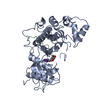
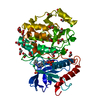

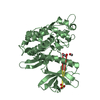
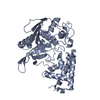
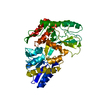
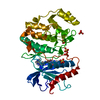
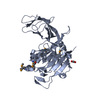

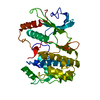
 PDBj
PDBj


